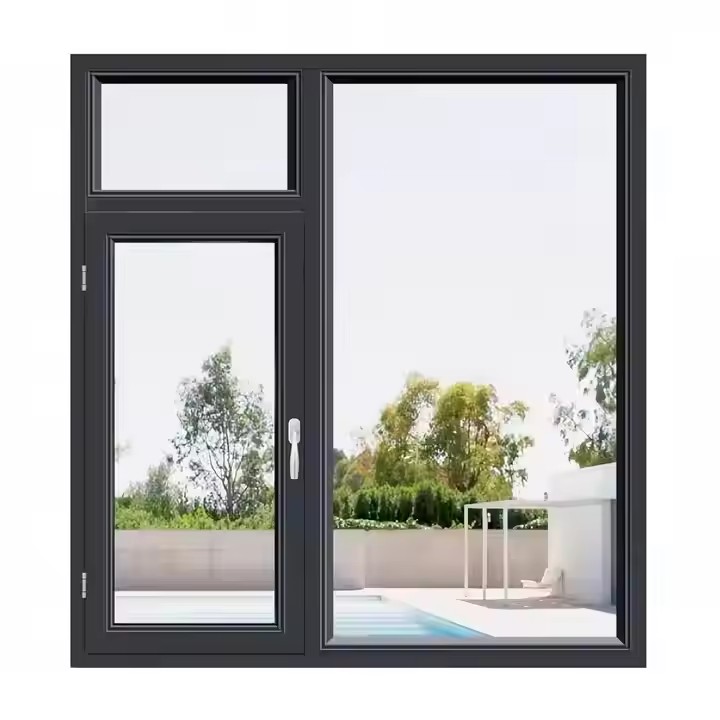Selection of Window Frame Materials
Material Strength: Choose window frame materials with high strength, such as broken bridge aluminum. It has excellent compressive and anti-deformation capabilities, can withstand large external forces, and is not easily damaged or deformed due to wind or collisions.
Profile Structure: Use profiles with a multi-chamber structure. This structure can increase the stiffness and stability of the window frame. At the same time, reasonably design the wall thickness of the profile. Generally speaking, the wall thickness should not be less than 1.4mm to ensure that the window frame has sufficient strength to support the overall weight of the window and resist external forces. For profiles with a reasonable structure, it is even more necessary to select products with greater strength, otherwise they are likely to break. Select door and window products with greater strength and better corrosion resistance, and also choose profiles that can adapt to the harsh weather in other foreign countries. When selecting profiles, it is also advisable to compare products from at least three suppliers as much as possible. Comparing products from multiple suppliers is an important step, because only after comparison can you know what is really important, which door and window products have good quality, and also select more cost-effective products and merchants who are more friendly to negotiate with. Then, it will be much easier to reach a cooperation in the next business deal.

Selection of Hardware Accessories
Hinges or Butt Hinges: Hinges or butt hinges are key connecting components of casement windows. Select products with good quality and strong load-bearing capacity. High-quality hinges or butt hinges are made of corrosion-resistant materials such as stainless steel or copper, which can ensure the smooth opening and closing of the window, and at the same time bear the weight of the window to prevent the window from sagging or deforming. Although hinges and butt hinges are in places that are not easily visible, it is still necessary to design them well and actually use hinges and butt hinges that are of good quality and wear-resistant.
Locks: Installing firm and reliable locks can enhance the stability of the window. A multi-point locking system can tightly lock the window frame and the sash at multiple points when the window is closed, evenly distributing the pressure, and improving the window’s anti-deformation ability and airtightness. Choose locks that are firm and reliable. Since locks are often used, it is also advisable to select locks with higher strength as much as possible to increase their service life. Only when the quality is good will more people be willing to purchase the materials.
Selection and Installation of Glass
Glass Thickness: Select glass with an appropriate thickness according to the size of the window and the usage environment. Generally speaking, the thickness of the glass for casement windows should not be less than 5mm. For larger windows or areas with strong wind pressure, consider using thicker glass, such as 6mm, 8mm or even thicker, to increase the strength and stability of the glass and prevent it from breaking due to wind pressure or external impact.

Installation Process: Adopt professional installation techniques and sealing materials to ensure a tight and firm connection between the glass and the window frame. When installing the glass, use high-quality sealing rubber strips or sealants to fill the gaps between the glass and the window frame. This can not only play a sealing role but also cushion the stress between the glass and the window frame, improving the stability and airtightness of the window. During the installation process, choose sealants with strong adhesion. And when some doors and windows have slight gaps during installation, it is necessary to choose such sealants with strong adhesion to block the gaps and make the doors and windows more harmonious.
Connection between the Window Frame and the Wall
Connectors: Use connectors with good quality and high strength to fix the window frame to the wall. The number and spacing of the connectors should be reasonably set according to the size and weight of the window frame. Generally, a connector should be installed every 500 – 600mm to ensure a firm and reliable connection between the window frame and the wall, and effectively transfer the external forces borne by the window to the wall. The quality of the connectors used should be carefully selected, because only by choosing those of good quality can the window frame and the wall be closely combined.
Installation Method: A flexible connection method should be adopted between the window frame and the wall, that is, a certain expansion joint should be reserved between the window frame and the wall, and filled with sealant or sealing materials. This connection method can effectively absorb the deformation caused by factors such as temperature changes and wall settlement, and avoid the window frame from deforming or being damaged due to excessive stress. The installation method of the wall should be analyzed according to specific situations. For example, if the gap is relatively large, try to use some paste-like materials to fill it. If the gap is relatively small, it is sufficient to use some adhesives to fill it.

Reinforced Structure Design
Middle Mullions and Stiles: For larger casement windows, middle mullions and stiles can be set in the window frame to divide the window into several smaller areas, increasing the overall stiffness and stability of the window. The design of the middle mullions and stiles should be reasonably calculated according to the size and stress conditions of the window to ensure that they can effectively share the external forces borne by the window. When selecting middle mullions, materials with high strength should be chosen, because high-strength materials are the best choice as they are required to provide support. Without this support, some unnecessary problems are likely to occur.
Reinforcing Ribs: Set reinforcing ribs inside the profiles of the window frame and the sash to enhance the strength and anti-deformation ability of the profiles. The shape and size of the reinforcing ribs should be designed according to the structure and stress characteristics of the profiles. Generally, shapes such as triangles or rectangles are used to improve the bending and torsional resistance of the profiles. Try to reinforce the ribs inside the window frame as much as possible, and it will be more stable after reinforcement.

